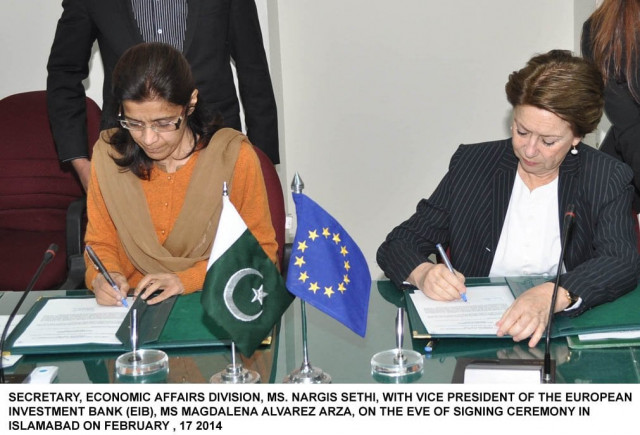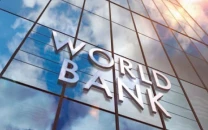Energy projects: EIB signs €100 million agreement with Pakistan
Keyal Khwar project finally achieves financial closure after 10 years.

Nargis Sethi, Secretary
Economic Affairs Division (EAD),
and Magdalena Alvarez Arza,
Vice President of the European
Investment Bank (EIB) signing the loan agreement on February 17, 2014. PHOTO: PID
The European Investment Bank (EIB) on Monday signed an agreement to provide €100 million (Rs14.4 billion) loan for the 128-megawatt (MW) Keyal Khwar hydropower project, helping the government achieve financial closure for a project that remained on paper even 10 years after its approval.
Due to the delay, the project cost has already escalated five times to €240 million or Rs34.5 billion. In 2004, the Executive Committee of the National Economic Council – the country’s highest project sanctioning body − approved the project at an estimated cost of Rs7.1 billion.
The loan agreement was signed by Nargis Sethi, Secretary Economic Affairs Division (EAD), and Magdalena Alvarez Arza, Vice President of the European Investment Bank (EIB). Ambassador of the European Union (EU) to Pakistan, Lars-Gunnar Wigemark, was also present on the occasion.
Wigemark said the EU was committed to expanding its investments in Pakistan, especially in the energy sector, according to a handout issued by the EU embassy.

The EIB will co-finance the project with the German Development Bank (KfW) and Pakistan Water Development Authority. In 2008, the KfW had signed €97 million loan agreement but due to delays in arranging funds, work on the project could not commence.
The scarcity of resources delayed the project for about 10 years, said Hasnain Afzal, General Manager Hydro Planning of Water and Power Development Authority (Wapda). He said the project is expected to be completed in the next four years and contract for civil work has already been awarded. Afzal, who is also in-charge of the project, said the contract for electro mechanical work will be awarded soon.
However, any deterioration in law and order may further delay the project, cautioned Afzal.
The project will supply 418 million units of low-cost renewable energy to the national power grid generating significant economic benefits. The project will also benefit local residents through improved transportation and employment opportunities and contribute to climate change mitigation and environmental sustainability in Pakistan, which are key priorities for the EIB and the EU, according to the statement issued by the EU embassy.
Successive governments have been facing the dilemma of striking a balance between ongoing projects and initiating new ones. Most of the projects have been started under political compulsions, while some had to be commenced to meet the country’s infrastructure requirements.
The PML-N government has recently completed an exercise aimed at closing down projects started in the Pakistan Peoples Party government under political compulsions to create fiscal space for projects that are on its priority list, according to Ministry of Planning and Development officials.
Since coming into power, the government has significantly increased the development project portfolio that has further thinned out the already scarce resources, they added. The officials said the government wanted to fast track work on energy, infrastructure and transportation sectors project while rest of the sectors have been put on the backburner, with few exceptions.
Sethi sought the EIB’s participation for energy efficient projects in Pakistan. She said the EIB’s financial assistance for the energy sector project will help in tackling the energy crisis. Sethi invited the EIB for participation in financing of energy efficient projects in the future as well.
Published in The Express Tribune, February 18th, 2014.
Like Business on Facebook, follow @TribuneBiz on Twitter to stay informed and join in the conversation.



















COMMENTS
Comments are moderated and generally will be posted if they are on-topic and not abusive.
For more information, please see our Comments FAQ